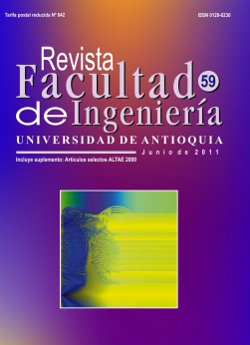Analysis of the elastic-plastic behavior of pressurized internal cracks in welded joints of low carbon steel pipes
DOI:
https://doi.org/10.17533/udea.redin.13759Keywords:
elastic-plastic behavior, coplanar cracks, welding joints, failure pressureAbstract
It was analyzed the elastic-plastic behavior of areas with pressurized planar internal cracks extending from the pattern metal region in the heat affected zone to the welding metal in welding joints of low carbon pipes subject to internal pressure. Using the ANSYS 8.0[TM] software, three-dimensional simulation of geometrical models of pipes containing the internal pressurized cracks was performed. The finite element method with non linear strain conditions was employed, considering the kinematic hardening rule and the real material properties for every location. The fracture paths and expressions to calculate the pressure in the crack and in the pipe that lead to fracture of the cracked area were obtained.
Downloads
References
J. L. González, R. Ramírez, J. M. Hallen, R. A. Guzmán. “Hydrogen Induced Crack Growth Rate in Steel Plates Exposed to Sour Environments”. Corrosion. The Journal of Science and Engineering, Vol. 53. 1997. pp. 935-943. DOI: https://doi.org/10.5006/1.3290278
J. A. Ramírez, J. L. González. “Hydrogen Induced Cracking of Welds in Steel Pipelines”. PVP-Vol. 469. Design and Analysis of Pressure Vessels and Piping: Implementation of ASME B31. Fatigue. ASME Section VIII and Buckling Analyses. PVP2003-2182. ASME. 2003. pp. 35-44. DOI: https://doi.org/10.1115/PVP2003-2182
J. L. González, J. M. Hallen. “Mecánica de Fractura en Ductos de Recolección y Transporte de Hidrocarburos”. 3er Congreso de Ductos PEMEX. 7-9 de diciembre de 1998. México. Vol. 1. 1998. pp. 183-191.
M. Iino. “The Extension of Hydrogen Blister-Crack Array in Linepipe Steels”. Metallurgical Transactions A. Vol. 9. 1978. pp. 1581-1590. DOI: https://doi.org/10.1007/BF02661940
J. L. González, A. Morales, J. M. Hallen. “Analysis of non-coplanar pressurized laminations in X52 steel pipe by non-linear finite elements”. The Journal of Pipeline Integrity. Vol. 3. 2004. pp. 147-156.
ASTM International. Standard Test Methods for Tension Testing of Metallic Materials. Designation: E8–01. 100 Barr Harbor Drive. PO Box C700. West Conshohocken. PA 19428-2959 U.S. 2001. pp. 5-6.
K. L. Lawrence. ANSYS Tutorial Release 7.0. Ed. SDC Publications. PO Box 1334. Mission KS 66222. 2002. pp. 4-19.
M. A. Meyers. K. K. Chawla. Mechanical Behaviour of Materials. Ed. Prentice Hall. New Jersey. 1999. pp. 152-153.
Norman E. Dowling. Mechanical Behavior of Materials, Engineering Methods for Deformation, Fracture, and Fatigue. 2a. ed. Ed. Prentice Hall. New Jersey. 1999. pp. 1-562.
API. Recommended Practice 579. Fitness for Service. API Publishing Services. Washington 20005. 2000. pp. F-2.
Downloads
Published
How to Cite
Issue
Section
License
Copyright (c) 2018 Revista Facultad de Ingeniería

This work is licensed under a Creative Commons Attribution-NonCommercial-ShareAlike 4.0 International License.
Revista Facultad de Ingeniería, Universidad de Antioquia is licensed under the Creative Commons Attribution BY-NC-SA 4.0 license. https://creativecommons.org/licenses/by-nc-sa/4.0/deed.en
You are free to:
Share — copy and redistribute the material in any medium or format
Adapt — remix, transform, and build upon the material
Under the following terms:
Attribution — You must give appropriate credit, provide a link to the license, and indicate if changes were made. You may do so in any reasonable manner, but not in any way that suggests the licensor endorses you or your use.
NonCommercial — You may not use the material for commercial purposes.
ShareAlike — If you remix, transform, or build upon the material, you must distribute your contributions under the same license as the original.
The material published in the journal can be distributed, copied and exhibited by third parties if the respective credits are given to the journal. No commercial benefit can be obtained and derivative works must be under the same license terms as the original work.










 Twitter
Twitter